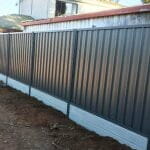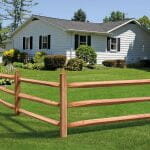Thinking about installing a split rail fence around your property? These kinds of fences not only enhance the aesthetic appeal but also demand low maintenance and are budget-friendly. In our detailed guide, we will delve into the aspects that affect the cost of split rail fences, examine various materials, and offer advice on how to economize on your fencing project.
A split rail fence costs $8 to $30 per linear foot. To fence a 1/4 acre property or paddock (420 linear feet) with post and rail will cost $3,360 to $4,999.
Factors such as your location, the wood you use and the grade of your land will influence cost.
What we cover
ToggleHighlights
- Split rail fence costs are determined by materials, labor and installation costs, as well as additional features.
- Material cost ranges from $8 to $30 per linear foot depending on the type of material used.
- Consider factors such as length and height of the fence, terrain of property, regulations/permits when budgeting for a successful split rail fencing project.
Average cost of post and rail fence
The average cost of a post and rail fence ranges between $1,500 and $3,500 according to Ergeon. While HomeAdvisor prices split rail fences at $9,960 to $24,900. Below is a breakdown of materials and labor costs.
| Quantity | Low | High | |
|---|---|---|---|
| Post and rail fence cost | Per linear ft | $8 | $29.85 |
| Materials cost | Per linear ft | $6 | $24 |
| Labor costs | Per linear ft | $2 | $5.85 |
| Total costs | 100 sq. ft | $800 | $2,985 |
Average installation cost for 100 linear ft = $1,893
Understanding split rail fence costs
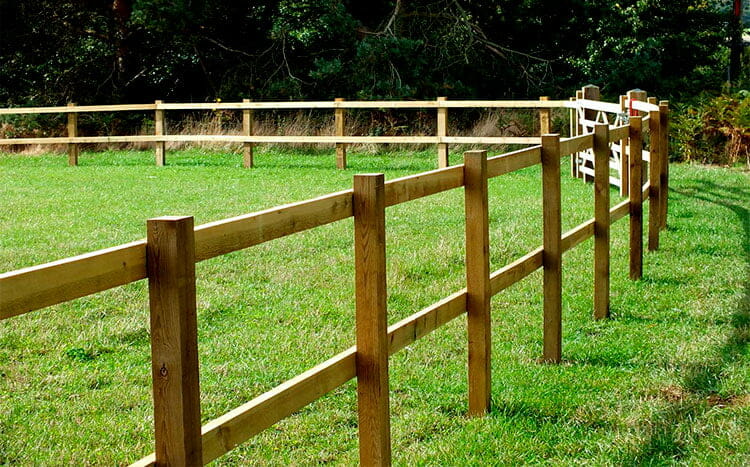
When planning a new split rail fence project, it’s important to consider the various factors that contribute to the overall cost. This includes the material used, labor and installation costs, as well as additional features and expenses that may arise during the project.
In the following sections, we will delve deeper into these factors to help you make an informed decision about your split rail fence investment.
Material costs
A key factor that affects the cost of a split rail fence is the material used. Common materials for split rail fences include:
- Wood
- Vinyl
- Composite
- Metal
Among wood options, cedar and pine are the most economical materials, offering a lower rail fence cost compared to other materials.
The cost range for a split rail fence is as follows:
- Pine: $1,800 to $4,500 for a 150-foot fence, averaging $11 to $21 per linear foot
- Cedar: $11 to $20 per linear foot
- Steel: $15 to $20 per linear foot
- Black locust: $20 to $30 per linear foot
It is important to note that these prices are for materials only and do not include labor costs.
Labor and installation costs
In addition to material costs, labor, and installation costs also play a significant role in determining the overall cost of a split rail fence. The cost of employing professionals to install a split rail fence could be approximately $500 to $1,200 per 150 feet of fencing. Factors such as the terrain and the length of the fence can influence the labor costs associated with installing a split rail fence.
One way to calculate labor costs for installation is by the number of linear feet installed. Additional expenses to consider when installing a split rail fence include renting a powered auger (typically costing $100 per day), land grading, and adding a gravel base to help with water drainage. It is essential to account for these additional costs while budgeting for your split rail fence project.
Additional features and expenses
When planning your split rail fence project, it’s important to consider not only material and labor costs, but also the split rail fencing cost that might arise from additional features such as gates, wire mesh, or painting/staining. Wire mesh, for example, can be acquired for approximately $1.66 per linear foot. Installing a gate to your split rail fence can be pricey, with costs reaching around $200.
It is essential to factor in any extra expenses when planning a split rail fence project. These may include:
- Installation of wire mesh or gate
- Fence removal or tree removal
- Yard grading
- Paint or stains
Being aware of these additional features and expenses will help you budget more accurately and avoid surprises during the installation process.
Post and rail costs per linear foot
On the low end, expect to spend anywhere from $8 per linear foot, and up to $29.85 per linear foot on the higher end. Depending on the location and condition of your existing land, labor will also cost you between $3 – $6 per linear foot.
Post and rail fence cost per acre
If you’re planning to fence an acre (836 linear feet), the installation costs will range between $6,688 to $24,955. Nevertheless, the final quote you receive for this job will depend on the number of railings used and the rail material.
Tip: For installations on large ranches, farms, and other multi-acre properties, many contractors will offer significant discounts since their total overhead costs are lower. Be sure to inquire about such discounts particularly on the materials and labor.
| Property size | Size in linear feet | Average costs |
|---|---|---|
| Quarter acre | 210 | $1,672 - $6,249 |
| Half acre | 420 | $3,344 - $12,476 |
| 1 acre | 836 | $6,688 to $24,955 |
Cost comparison by material
As we’ve seen, the choice of material can significantly impact the cost of your split rail fence. Here are the average costs per linear foot for different types of split rail fences.
- Wood fences (such as cedar and pine): $9 to $18
- Vinyl split rail fences: $15 to $40
- Composite fences: $25 to $50
- Metal split rail fences (including steel and aluminum options): $15 to $32
In the following sections, we will explore each material in more detail, examining their respective advantages and disadvantages.
| Rail material | Low | High |
|---|---|---|
| Pine | $9 | $16.50 |
| Cedar | $11.50 | $18 |
| Vinyl | $15 | $40 |
| Composite | $25 | $50 |
| Aluminum | $22 | $32 |
| Steel | $15 | $20 |
Wood fences
Wood is a popular choice for wood split rail fences due to its durability and cost-effectiveness. Common wood materials used for split rail fences include cedar, pine, and black locust. Cedar split rail fences cost between $11.50 and $18 per linear foot, while pine fences range from $9 to $16.50 per linear foot. Black locust split rail fences are the most expensive wood option, costing around $20 to $30 per linear foot.
Although wood fences are generally more affordable, they do require regular maintenance and can be vulnerable to decay and insect damage. However, the most economical pine fence option would be a two-rail split rail fence constructed of cedar or pine, providing a balance between affordability and durability.
Vinyl fences
Vinyl split rail fences offer several benefits, including low maintenance, durability, and a variety of colors and styles. Vinyl fences typically range in cost from $15 to $40 per linear foot, making them more expensive than wood fences. However, their long-lasting and low-maintenance nature can make them a worthwhile investment for some homeowners.
Despite their advantages, vinyl split rail fences can be more susceptible to damage from extreme temperatures. Additionally, the higher cost of vinyl fences may be a deterrent for some homeowners. It’s important to weigh the benefits and drawbacks of vinyl fencing before making a decision on the best material for your split rail fence project.
Composite fences
Composite split rail fences are made from a combination of recycled wood and plastic, offering the benefits of low maintenance, durability, and a variety of colors and styles. The cost of composite fencing ranges between $25 and $50 per linear foot, making it more expensive than wood and vinyl fences.
While composite fences offer several advantages, they can also be affected by extreme temperatures. This factor, along with their higher cost, may influence homeowners when choosing the best material for their split rail fence project.
It’s essential to consider the unique characteristics of composite fencing before making a final decision.
Metal fences
Metal split rail fences, including steel and aluminum options, are known for their high durability, minimal maintenance, and a range of colors and designs. Steel split rail fences cost between $15 and $20 per linear foot, while aluminum fences range from $22 to $32 per linear foot for materials only.
However, metal split rail fences, such as steel split rail fences, can be more expensive than other materials and can be prone to rust and corrosion. When considering a metal split rail fence, it’s crucial to weigh the advantages and disadvantages of this material and determine if it’s the best choice for your fencing needs.
Factors that affect split rail fence costs
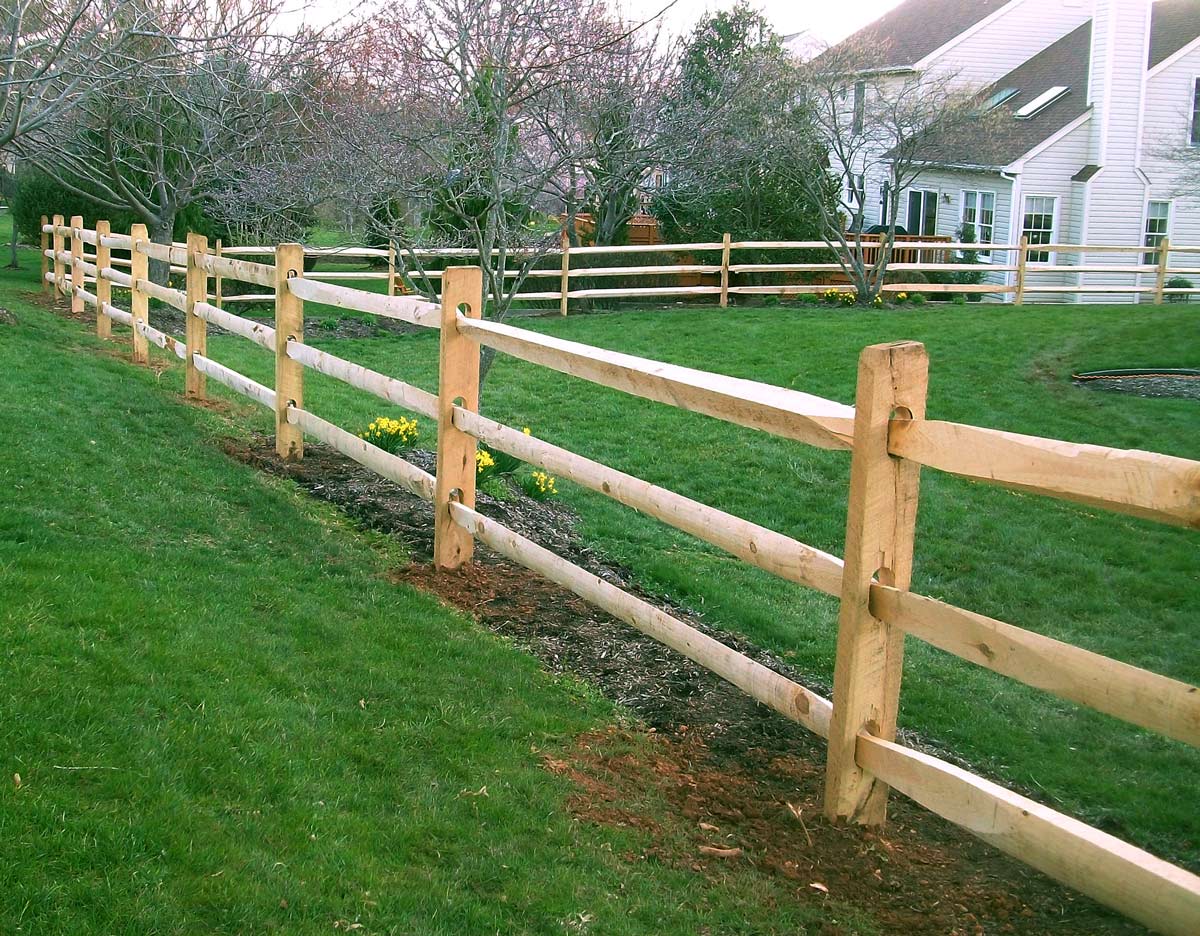
As we’ve explored in the previous sections, several factors can influence the overall cost of a split rail fence. These include:
- The type of material used
- The length and height of the fence
- The terrain of the property
- Any additional features and expenses that may arise during the project.
By understanding these factors, you can make informed decisions about your split rail fence project and potentially find ways to reduce costs.
Fence length and height
The length and height of your fence play a significant role in determining the overall cost of materials and labor. Longer fences require more materials, increasing the cost of the project. Similarly, taller fences necessitate more labor, resulting in a higher overall cost.
When planning your split rail fence project, it’s essential to accurately measure the area and consider the desired height of your fence. This will help you budget for materials and labor costs and ensure that your fence meets your needs while staying within your budget.
Property terrain
The terrain of your property can also affect the cost of installing a split rail fence. Hilly or irregular terrain may require additional materials and labor to install the fence. Rocky terrain or areas with a lot of tree roots can make installation more difficult, leading to higher costs. Additionally, the placement of fence posts in such conditions might also contribute to the overall expenses.
Before starting your split rail fence project, it’s crucial to assess your property’s terrain and consider any potential challenges it may pose during installation. This will help you plan and budget for your project more effectively, ensuring that your fence is installed correctly and lasts for years to come.
Local regulations and permits
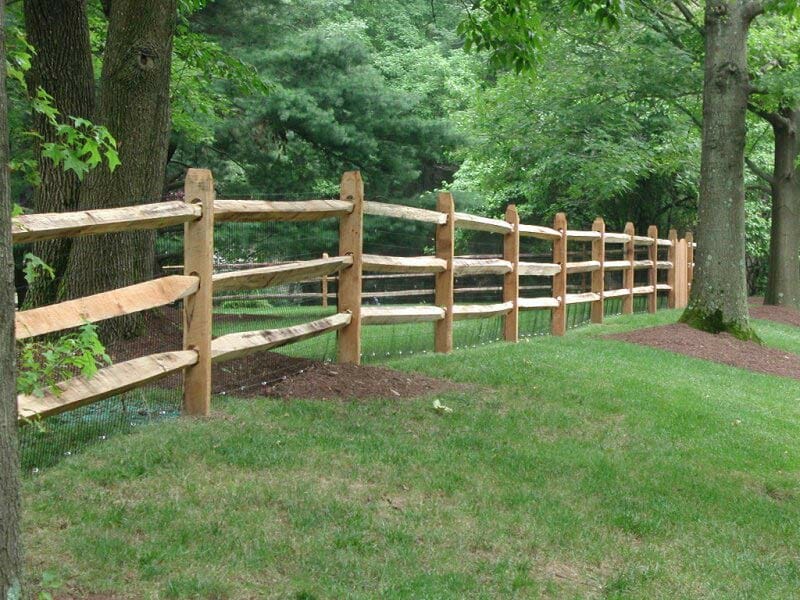
Local regulations and permits can also impact the cost of your split rail fence project. Requirements for size, placement, and permits may differ depending on your location. It’s important to assess local building codes, zoning laws, and neighborhood association rules to ensure your fence project meets all necessary specifications.
Failing to comply with local regulations and permits can result in fines or the need to modify or remove your fence, leading to additional costs. By researching and adhering to local requirements, you can avoid these potential issues and ensure that your split rail fence project is completed without any complications.
Important: Every state and county in the United States has its set fence laws and regulations that govern the height and setback regulations of that area. Some Homeowners Associations also have separate by-laws governing the fencing of your neighborhood.
Read more about the fence laws in your area here.
Post and rail fence labor costs
The total costs you’ll incur in labor costs will depend either on how fast your installers can complete the job, or how big your yard is.
Most contractors will charge you anywhere from $3 – $5 per linear foot or between $35 – $60 per hour on labor.
The simple installations will take a professional 1 – 2 days to complete and up to 5 days for the large, difficult jobs. Generally, a team of 2 – 4 workers should install between 200 – 300 linear feet of post and rail fencing every day.
Cost of gates, doorways, and accessories
Gates and doorways on post and rail fences are usually cheap since they don’t utilize a lot of material. Expect to spend anywhere from $100 – $300 for every gate and doorway you install depending on the type and size.
Adding other accessories such as lighting or decorations will also cost you slightly more. The more additions you install, the more money you’ll spend.
Cost of post and rail by number of rails
The cost of a post and rail fence is also affected by the number of horizontal rails you decide to use. The average cost of one rail stands between $1.50 – $4.50 per linear foot depending on the size.
Most homeowners prefer the 3-rail fencing because they are tall and often stronger than a 2-rail fence. Its cost is, however, higher at around $8 – $14 per linear foot compared to the $3 – $9 per linear foot of 2-rail.
Each railing is available in 1 by 6, 2 by 6, and 2 by 4 sizes, or 8 – 11 feet span for wooden rails.
| Number of rails | Cost per linear foot |
|---|---|
| 2 - rail fence | $9 - $13 |
| 3 - rail fence | $12 - $16 |
| 4 - rail fence | $16 - $19 |
| 5 - rail fence | $18 - $24 |
Cost of other extra services
When accounting for the post and rail fence installation costs, there are several other extra services that you should add to your budget for a successful job. These include;
Land grading
While post and rail fences can work on almost any terrain, in areas where the land’s slope is too steep, some grading will be needed to even out the fence. Depending on the amount of excavation and re-sloping required, this process will cost you between $900 – $3000.
Fence removal
If you have an existing fence that can’t be repaired, you’ll need to remove it before installing the new split rail fence. This process will cost you about $3 – $6 per linear foot if you choose to hire a professional.
Keep in mind; If the old fence was installed using concrete and other thick materials, the removal costs will be higher.
Tree/bush removal
Removing obstacles such as trees and bushes along your installation path may force you to hire a tree service company. Doing this will set you back an additional $400 – $1,100 per plant removed, or $10 -$14 per foot of the plant’s height.
Additional cost factors
- Size and Height – Tall and long post and rail fences generally require more material than short and smaller fences. You’ll therefore spend more on a fence taller than 5 feet and longer than 8 feet.
- Wire mesh – Installing a wire mesh with the post and rail fence increases your overall costs by around $1.80 per linear foot.
- Soil condition – The condition of the soil in your area affects how difficult the installation will be. For instance, Clay soils are very dense meaning digging will take more time. Loam soils can be unstable hence require large posts or additional gravel to improve balance. Sand soil may force the contractors to transport extra water on-site to improve its retention. All these mean additional costs.
- Shape of rails – Round rails cost slightly more than flat rails, but they last longer and thus are a better long-term investment.
DIY vs. professional installation
When it comes to having a split rail fence installed, homeowners often wonder whether they should take on the project themselves (DIY) or hire a professional fence contractor. Both options have their advantages and disadvantages, which will be explored in the following sections.
By understanding the costs, benefits, and challenges of each installation method, you can make an informed decision that best suits your needs.
DIY installation costs
Installing a split rail fence on your own can lead to significant cost savings compared to hiring a professional. On average, homeowners can expect to pay approximately $17.75 per linear foot for a 3-rail split rail fence when installing it themselves. However, it’s important to note that these costs can vary depending on factors such as the material used, location, and the length and height of the fence.
While DIY installation can be more cost-effective, it’s essential to consider the potential challenges and risks associated with this approach. These include the possibility of errors, the need for specialized tools, and the risk of injury. It’s important to weigh these factors against the potential savings before deciding to install your split rail fence on your own.
Hiring a professional
Hiring a professional fence contractor to install your split rail fence can provide several advantages. A professional fence installer can complete the project in a shorter time frame (typically 2-3 days) and ensure a higher quality installation. While the cost of professional installation is generally higher, ranging from $10 to $30 per linear foot, the benefits of a well-installed and durable fence may outweigh the additional expense.
It’s crucial to weigh the costs and benefits of hiring a professional fence contractor against the potential savings of DIY installation. If you’re unsure about your ability to install the fence yourself or if the project seems too time-consuming or challenging, hiring a professional may be the best option to ensure a successful and long-lasting split rail fence.
Pros and cons of post and rail fence
Pros
- Aesthetically pleasing and blends well with the natural landscape
- It’s easy to install and repair
- No sharp edges that could hurt children or animals
- Sturdy when properly installed and can be used to pen livestock
- Materials like cedar and vinyl used for the railing require minimal maintenance
- Wooden options are cost-effective
Cons
- Doesn’t provide any real security or privacy
- Doesn’t keep up out smaller animals like dogs unless you use a wire mesh
- Some rail materials can be expensive
- Doesn’t provide any shade
Tips for reducing split rail fence costs
Now that we’ve explored the various factors that contribute to split rail fence costs, let’s look at some strategies for minimizing these costs. By implementing these tips, you can ensure that your fence project stays within your budget while still meeting your needs and preferences.
One way to reduce costs is to purchase the materials yourself. This can be a great way to work.
Bulk purchasing
One way to reduce the cost of your split rail fence project is through bulk purchasing. Buying materials in large quantities can lead to discounts or other cost savings. This can be particularly beneficial for larger split rail fencing projects or if you plan to install multiple fences on your property.
When considering bulk purchasing, it’s important to ensure that the materials are appropriate for the task at hand and compare prices between different suppliers to guarantee the most advantageous deal. By taking advantage of bulk purchasing, you can potentially save a significant amount on your split rail fence project.
Choosing the right material
Selecting the most appropriate material for your needs can also help reduce costs. As previously discussed, materials such as cedar and pine are more economical options for split rail fences, while vinyl, composite, and metal fences can be more expensive.
It’s crucial to factor in your budget, the climate in your area, and the level of durability you require when choosing the right material for your split rail fence project. By selecting the most suitable material for your needs, you can ensure a cost-effective and long-lasting fence.
DIY installation
Finally, installing your split rail fence yourself can lead to significant cost savings compared to hiring a professional fence contractor for split rail fence installation. However, DIY installation comes with its own set of challenges and risks, such as the possibility of errors, the need for specialized tools, and the risk of injury.
If you’re confident in your ability to install the fence and are willing to invest the time and effort, DIY installation can be a cost-effective option. Just be sure to accurately measure the area, carefully follow instructions, and utilize the appropriate tools for the task to ensure a successful and long-lasting split rail fence.
FAQ's
On average, a split rail fence will cost around $20 per linear foot, or $2,853 for materials and professional labor.
Costs can range anywhere from $11 to $29 per linear foot, depending on the material used and your location.
Split Rail Fencing is a cost-effective and easy-to-maintain fence option. It requires minimal posts and rails to assemble, and can be easily repaired and maintained as needed.
This makes it a great choice for many people.
Split rail fences can have a life expectancy of up to 30 years when properly maintained, with an average lifespan of around 12-20 years. Pressure treated fences typically last up to 12 years, while larger posts last about 20 years.
Untreated split rails can survive for up to 10 years, and cedar fences may last between 10-15 years.
An alternative to a split rail fence is a Ranch Rail Fence, also known as Horse Fence, Farm Fence, Field Fencing or Board Fence. It’s becoming popular for various settings and provides a sleeker look than the traditional split rail fence.
Split rail fences are typically made from wood, vinyl, composite, or metal.











